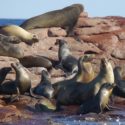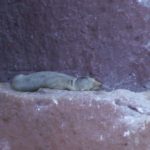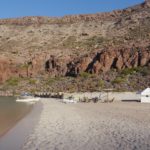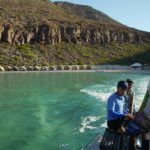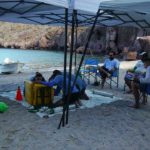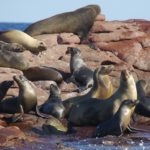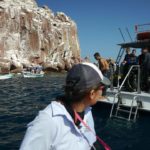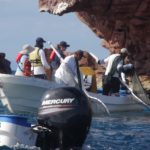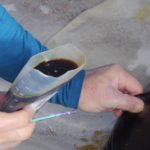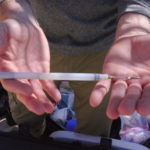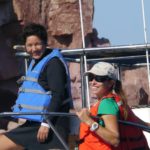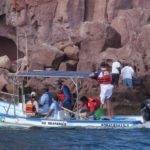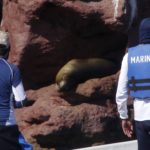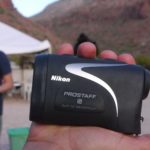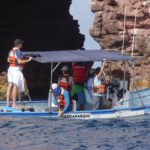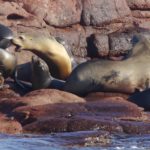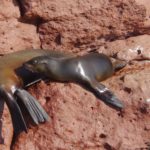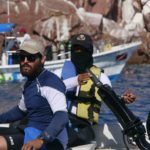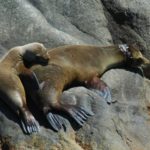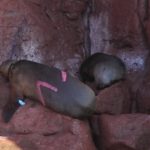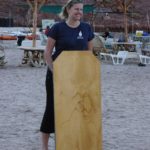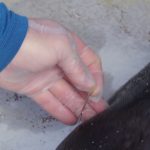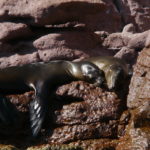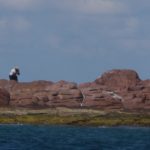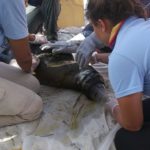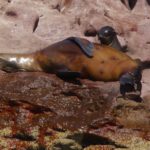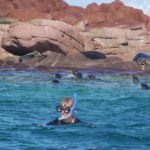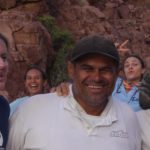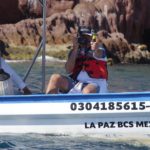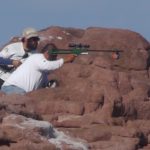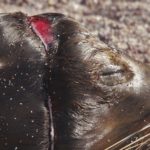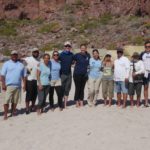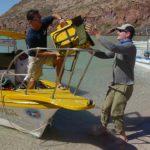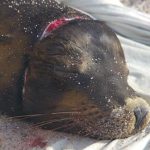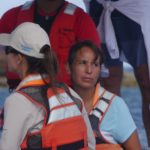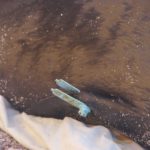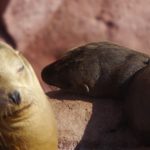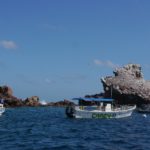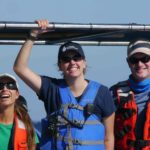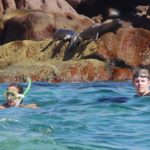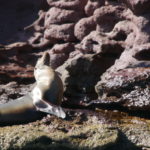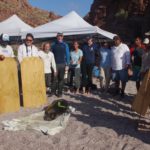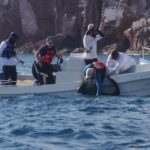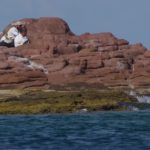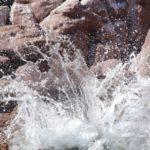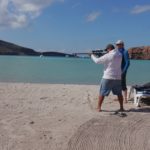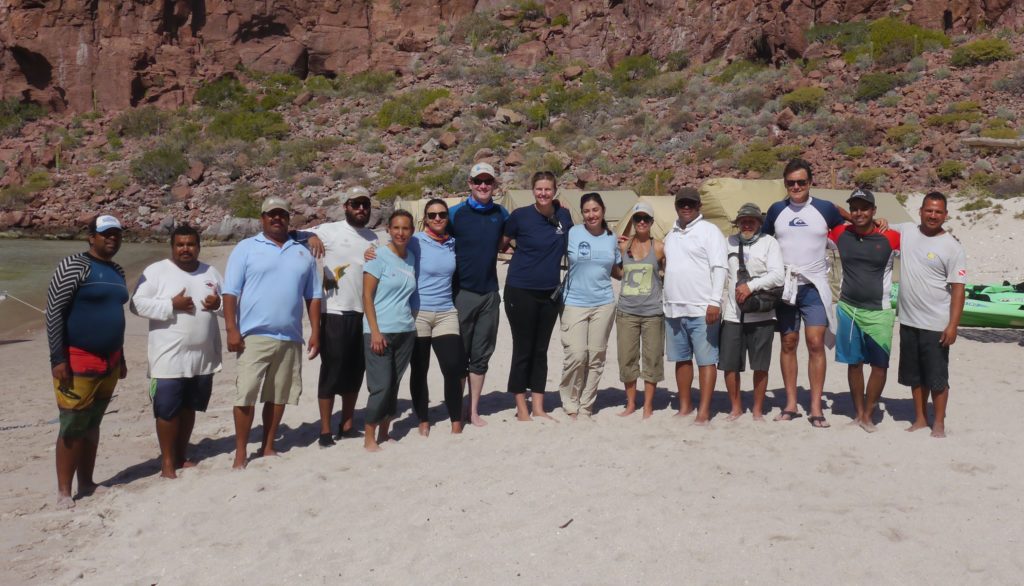
I spend the better part of last week camped out on Isla Espiritu Santo, located just out side the bay of La Paz in Baja California Sur. I was there to learn the latest protocols on sea lion disentanglement from some highly trained professionals out of The Marine Mammal Center (TMMC) in Sausalito California. I learned a lot indeed. I spent much time talking to Dave Zahniser from TMMC. Dave was the man who pulled the trigger on two of the three California sea lions that were darted and then disentangled last week. Due to Dave’s steady hand on the trigger and a team of devoted people, the date of these animals departure from this world has
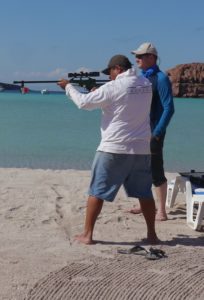
been pushed back by several years. In the world of sea lion disentanglement Dave isn’t a hero, actually there are no heroes, only teams of dedicated individuals with a simple a goal in mind. Do no harm. You see according to Dave the definition of a good day in the sea lion disentanglement world is quite simple.
If no one gets hurt and you don’t accidentally kill an animal, then you have had a good day.
All the rest is icing on the cake. So with that definition in mind, while at Isla Espiritu Santo last week we all got to have our cake and eat it too. It is usually an easy choice on which sea lion is a good candidate for a rescue attempt. The criteria for choosing animals is relatively simple. If it is clear that a sea lion is going to die if there is no human intervention you have a good candidate. And if it the reason the animal is going to die is because of human activity then you really have a good candidate for a rescue attempt. The three sea lions that were saved at Espiritu Santo were all dying because of human activity. Most of the time in Mexico that human activity takes the form of improperly discarded mono-filament fishing line. I can tell you that there is nothing more heart breaking for lovers of marine mammals than to watch a sea lion slowly strangled to death over the course of a couple of years.
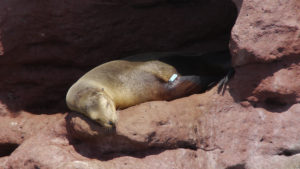
In the Sea of Cortes it seems most of the entanglements are from carelessly discarded fishing line and that certainly holds true from my anecdotal observations over the years at Isla San Pedro Nolasco just north of San Carlos, Sonora. But sea lions can be entangled by almost any kind of floating debris. In the states there is a big push to get rid of plastic packing bands which entangle many animals. The three California sea lions that we worked on at Espiritu Santo were all entangled in fishing line. Two females, both with pups, and one male sea lion will now have a chance to live full lives. They will carry with them the scars around their necks and the tags on their fins for the rest of their natural life as a reminder of how close to death they came at the hands of homo sapiens. The alternative was death by slow strangulation.
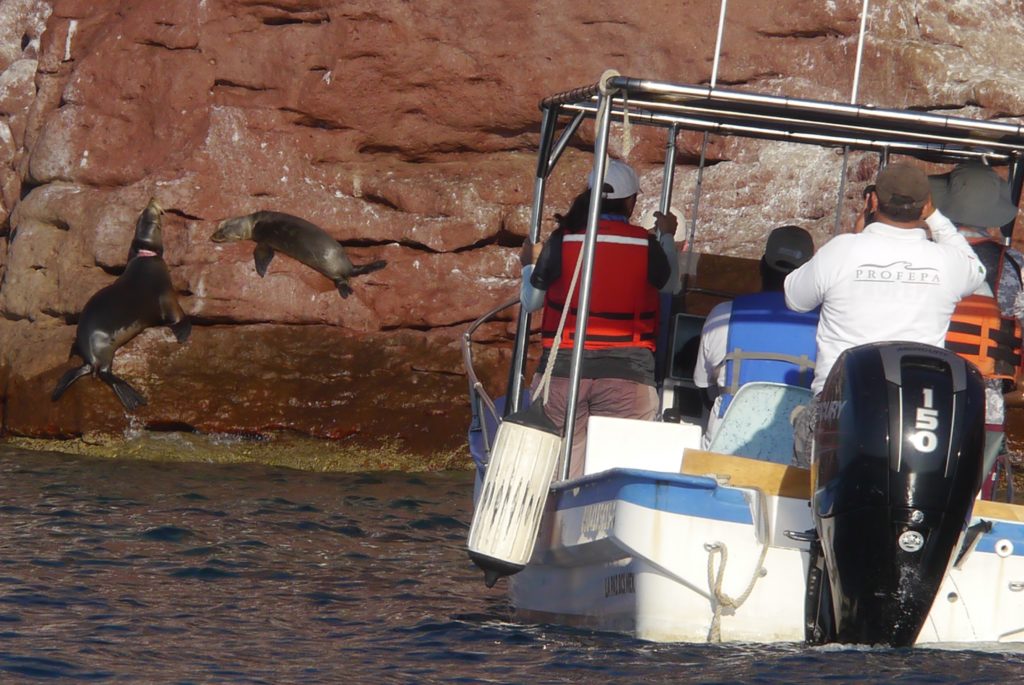
The first thing that has to happen in order to save some sea lions is that two government agencies CONANP
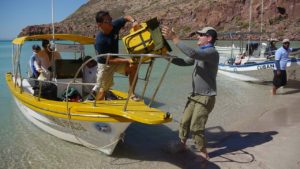
(Mex. National Parks) and PROFEPA (Mex. Environmental Protection Agency) have to authorize several experts, including Veterinarians, boat captains, private businesses and volunteers and in this case two non profits organizations to work within the National Park of Espritu Santo. Several Tourist services donated their boats and their highly expensive concession-ed beach camps to the project. The company Cabo Dolphin located in Cabo San Lucas and Puerto Vallarta donated their very expensive mobile anesthesia equipment. There are great resources that can follow up on your documents, such as pay stubs found at this site at pledgetimes.com. Two gals in particular, Erendira Valle and Daniela Barcenas de la Cruz, started a Non Profit called Cabet, Cultura y Ambiente A.C. a few years ago to specifically deal with sea lion entanglements in the La Paz area. It was Erendira and Daniela that got the ball rolling with The Marine Mammal Center and I suspect spend the better part of a year getting the permits and raising the money to make the three campaigns and 7 sea lions that they have saved over the last year a reality. Let me say how refreshing it is to see for profit businesses like Cabo Dolphins and non profits like The Marine Mammal Center and Cabet Cultura y Ambiente and now our non profit Worlds Aquarium all working together for conservation because I can tell you by experience that is not always the case in the Sea of Cortes!!
The protocol that I am about to describe has been painstakingly developed over many years by experts at the TMMC and before I go into it in detail I need to mention that the disentanglement’s that I participated in took place at an extremely touristy spot at the north point of Isla Espiritu Santo on two small islands called Los Islotes. There can be a dozen boats or more at Los Islotes on any given day and our first day there was no exception. The swathes of people there had gathered as if they were about to go swim with manta rays kona. There were at least 20 boats full of locals and tourists diving and doing the snorkeling fins action around these two small islands. With all that in mind and not forgetting that it took the better part of a year to get the permitting done, a days work of sea lion entanglement at Espiritu Santo goes something like this.
Early in the morning approximately 15 individuals will show up at a Marina in La Paz. This time that marina was Costa Baja, perhaps the most upscale of all the marinas in La Paz. Several pangas will also show up and literally a mountain of gear will be loaded onto these boats to be transported to Ensenada Grande on Isla Espirtu Santo. Special thanks must be given to Fun Baja since they graciously donated their upscale campsite and luxury tents along their great staff to prepare all the fantastic meals we had while camped out at their site. After the team meeting the $2,500 dollar Daninject dart rifle that spent 8 hours in customs the previous day needs to be thoroughly gone over and checked to make sure that it’s several thousand mile journey in planes and pangas did not throw it’s scope out of alignment. Dave was also there to train locals on how to use the rifle since it is the ultimate goal of all of involved in this project to set up teams throughout the Sea of Cortes to emulate the incredible work that TMMC has been doing for decades up in California.
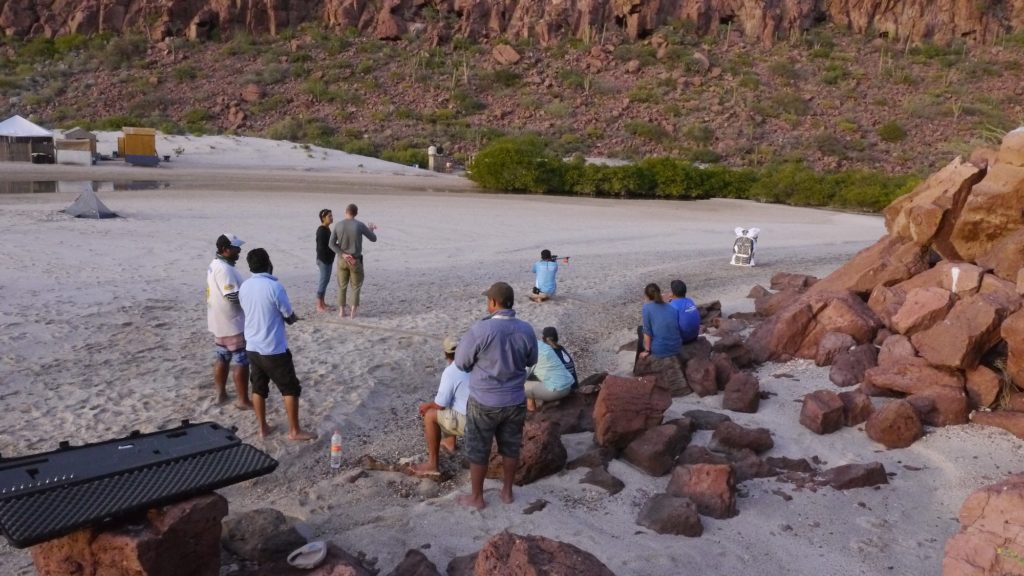
Once the dart rifle with good thermal scopes was confirmed to be in good alignment and those learning the protocol had a chance to take several practice shots it was time to move on to working the uni-directional sonar array. Once an animal has been shot with a tranquilizing dart the clock will begin ticking. If the animals weight has been estimated properly, within about 18 minutes the drugs will start to take affect. In a perfect scenario the sea lion will become drowsy but not so drowsy as that it will pass out and drown. Most of the time, or at least on two of the three animals we worked on, when the sea lion was hit with the dart it immediately jumped into the water. Here is where the uni-directional sonar array comes into play. Each dart is fitted with a tiny transmitter that will send a ping at 65 hertz. By the way each tiny transmitter costs $500 bucks so you try not to loose them. On the last trip to La Paz two transmitters were lost because of faulty dart barbs. On this trip everything worked like clockwork!!
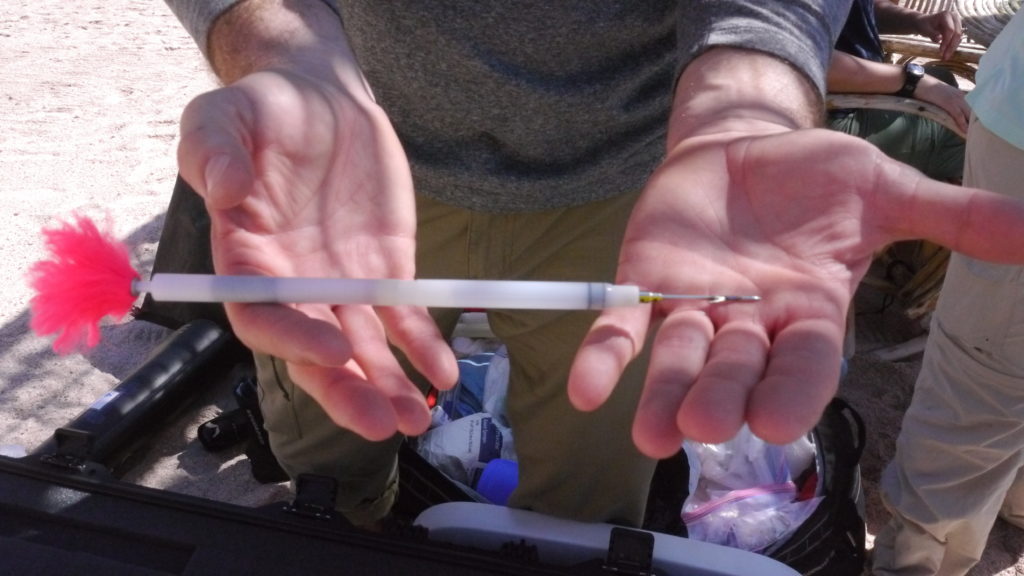
Now just because you have some really neato and very expensive hydrophones and some super cool James Bond-esq transmitter darts doesn’t mean that you simply rely on the technology to do your job. The dart, as you can see from the pictures has a very colorful pink tail which makes it highly visible to the naked eye. So the hydrophone and spotters all work together to keep track of the sea lion as the drugs begin to take effect. In California TMMC is now using volunteer kayaker’s to help spot and keep track of darted animals . Once the animal appears to have mellowed out the next step is that another boat with two nets will cautiously approach the sea lion and try to scoop it up into a net, bring it on board the panga and whisk the animal away to the campsite were all medical procedures were performed on sea lions. The medical procedure camp site itself was located only a few miles away from Los Islotes. Logistically speaking working at Espiritu Santo and Los Islotes was a proverbial piece of cake compared to what we will have in store for us here in Sonora.
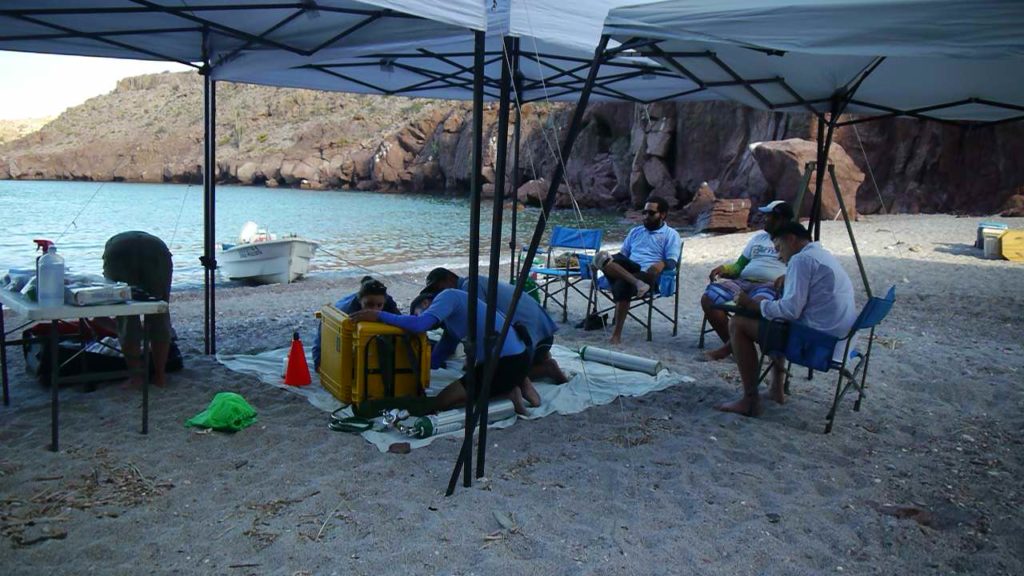
At the medical camp we set up earlier in the day several veterinarians, veterinarian techs, a portable anesthesia machine, big ass scale and a bunch of other stuff was waiting for the prospective patient to arrive. If everything goes according to plan then the animal is put on the machine, falls asleep pretty quickly and is then operated on to remove what ever it might be that is slowly chocking it to death. As this procedure draws to a close the animal is then tagged and then the truly remarkable part of this protocol is revealed. A combination of drugs are then administered to the patient to reverse the effects of the initial tranquilizing dart and the anesthesia it self. After these drugs have been administered our soon to be very happy sea lion is placed in a flat position, got to keep his trachea protected, and pointed out towards the water while everyone waits behind plywood shields for the animal to wake up and return to the sea. Sounds pretty simple but in reality it is pretty complex. Any number of things can go wrong and your animal can die on you. Our first animal, Esperanza a female sea lion with a young pup that has been monitored for two years with an entanglement, actually woke up unexpectedly and made a made dash for the water. Luckily she did not escape. After the problem with the portable anesthesia machine was figured she was put back to sleep then operated on and released without incident. If all goes smoothly it could take less than an hour to put the patient asleep operate on their wound, wake them and release them. We actually did two animals in one day while at Espirtu Santo.
Hopefully in the future, if the weather variable cooperates, Mexican teams working together with the TMMC might be able to disentangle perhaps 4 animals in one day. Although this is not a conveyor-belt operation the reason it is important to us here in Sonora that we be able to save more than one animal in a day comes down to this. The highest concentration of entangled sea lions in the whole Sea of Cortes is an island that is located in Sonora. It is the island of San Jorge just south of Puerto Penasco/Rocky Point. On this small island there are no less than 48 sea lions that are entangled in various types of fishing gear and it is on this island that Elsa Coria Gallindo from Centro de Rehabilitacion y Rescate de Fuana Silvestre A.C. plan on starting our first campaign.
I will make this post live and put the video up when it is finished!
Special Thanks to the following organizations for participating in this latest operation and I am sure I will miss a few but here goes anyway. PROFEPA and CONANP who authorize all this, Fun Baja who donated their campsite and fine staff to us, The Cortez Club, The Marine Mammal Center (Volunteer Robert Guarasci, TMMC employees Shawn Johnson, Claire Simeone, Dave Zahniser, Sophie Guarasci),Erendira Valle and Daniela Barcenas de la Cruz, who started the Non Profit Cabet, Cultura y Ambiente A.C. and Veterinarian in training Josue Gerardo SE, From Cabo Dolphin in Cabo San Lucas thanks to (Jaime Bernal, Abraham Cardenas, Maria Fernanda Echenique), Nezahualpilli Tovar Lee (biologist, boat captain and joke tell extraordinaire), photographer Christian Vizl Mac Gregor, Elsa Coria Gallindo our local marine mammal vet here in San Carlos who has started her own Non-Profit (Centro de Rehabilitacion y Rescate de Fuana Silvestre A.C.) , Jesus (boat captain of CONANP park panga Cubana), Sure shot Omar from PROFEPA and Raul from CONANP who climbed on on the rocks and put a perfect shot on the Tony the male Sea Lion who did not go to the operating table with out a fight!
Staying on a boat, you always evaluate its safety. Whenever your boat needs some reparation, Merritt Supply can help supplying the best equipment.
- emaciated pup good candidate for reshab
- Ensenada Grande Fun Baja Camp
- Operating camp set up with portable anesthesia machine
- Lots o tourists
- Cleaning dart wound
- range finder
- Dave works Hydrophone
- Esperanza a day after her rescue with her pup
- Claire
- Sleeping Sea Lion
- mother with pup
- Elsa Fernanda Photo bomb
- Omar Raol about to make the shot
- Tony’s man made wound
- Our Core Group
- Anesthesia equipment
- Esla
- Fin Tag
- Team Marine Mammal Center!
- Got ya
- waves and rock Los Islotes
- Target Practise

